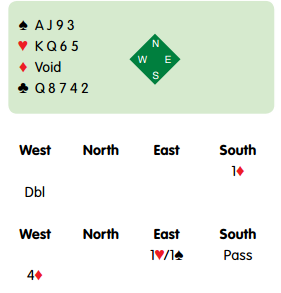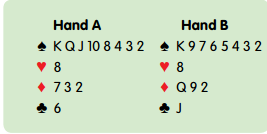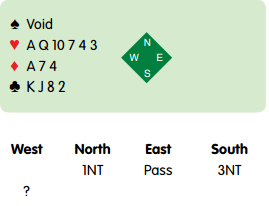The official definition of a freak hand varies. Some say any hand with a void or two singletons. Others say a hand with at least eight cards in one suit or eleven cards in two suits.
 Source: Mr. Bridge
Source: Mr. Bridge
The official definition of a freak hand varies. Some say any hand with a void or two singletons. Others say a hand with at least eight cards in one suit or eleven cards in two suits. Three-suited hands with a void rarely present a problem. If partner bids your short suit, you proceed cautiously. If the opponents bid your short suit or if partner bids one of your long suits, you will bid more vigorously.

With this hand, you make a take-out double of an enemy 1

opening, or a splinter raise if partner opens one of a major. Conversely, if an opponent opened one of your long suits, you would probably pass; if partner opened 1

, you would make a simple change of suit response. When you have a long suit, much depends upon suit quality. When the quality is poor, fit becomes important.

With Hand A, you do not really care whether partner has spade support. Even facing a void, you have just one spade loser. With Hand B, by contrast, you might easily lose three trump tricks if partner is void. You would be much more inclined to open 4

with Hand A than with Hand B. With both Hands, you would expect the trumps to play for no loss facing A-x. With a two-suited hand, it is usually important to show both your suits. If you play in the wrong suit, which is clearly a risk if you show only one suit, you may find yourself forced and running out of trumps.

Should you open 1

or 1

with this hand? The answer really is neither. If you pass, you might well get the chance to make an unusual 2NT (or 3NT) overcall (if an opponent opens in a major) and show both your suits at once. Of course, if partner is the one to open 1

or 1

, you will know of the probable misfit and take the auction slowly.

With this stronger hand, you are too good to adopt the same tactic. You open 1

correctly. Should you now reverse into 2

; after all, the hand comes out as only four losers on the
losing trick count?
You should beware of using the
LTC when you have not found a fit. You need to remember that you have only 12 HCP and that you have a void in partner’s suit. Moreover, as the opponents have remained silent, partner probably has a few spades as well. It is highly unlikely that you will miss game if you make a simple 2

rebid. By contrast, if you rebid 2

and partner’s hand does not fit yours, you could easily go overboard.
On that hand, there were two warning signals of a misfit: a bid from partner in your short suit and a lack of opposing bidding. A third possible warning signal is if the opponents bid no-trumps.

Partner probably holds six spades (you would expect the opponents to find an eight-card spade fit if they have one) and is likely to be short in hearts. Bidding 4

would be foolhardy. A much better action is to double. As the meaning of such a double is, ‘please try to find my suit,’ this should deflect partner from a spade lead to a heart lead.
 Source: Mr. Bridge
The official definition of a freak hand varies. Some say any hand with a void or two singletons. Others say a hand with at least eight cards in one suit or eleven cards in two suits. Three-suited hands with a void rarely present a problem. If partner bids your short suit, you proceed cautiously. If the opponents bid your short suit or if partner bids one of your long suits, you will bid more vigorously.
Source: Mr. Bridge
The official definition of a freak hand varies. Some say any hand with a void or two singletons. Others say a hand with at least eight cards in one suit or eleven cards in two suits. Three-suited hands with a void rarely present a problem. If partner bids your short suit, you proceed cautiously. If the opponents bid your short suit or if partner bids one of your long suits, you will bid more vigorously.
 With this hand, you make a take-out double of an enemy 1
With this hand, you make a take-out double of an enemy 1 With Hand A, you do not really care whether partner has spade support. Even facing a void, you have just one spade loser. With Hand B, by contrast, you might easily lose three trump tricks if partner is void. You would be much more inclined to open 4
With Hand A, you do not really care whether partner has spade support. Even facing a void, you have just one spade loser. With Hand B, by contrast, you might easily lose three trump tricks if partner is void. You would be much more inclined to open 4 Should you open 1
Should you open 1 With this stronger hand, you are too good to adopt the same tactic. You open 1
With this stronger hand, you are too good to adopt the same tactic. You open 1 Partner probably holds six spades (you would expect the opponents to find an eight-card spade fit if they have one) and is likely to be short in hearts. Bidding 4
Partner probably holds six spades (you would expect the opponents to find an eight-card spade fit if they have one) and is likely to be short in hearts. Bidding 4



























